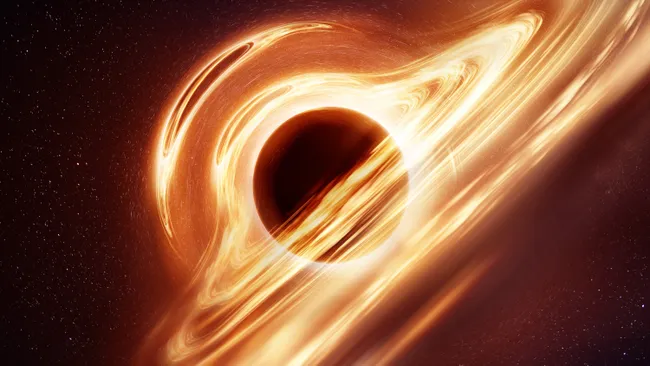What is a Black Hole?
A black hole is a region of spacetime in which gravity is so strong, that nothing, not even light or any other form of electromagnetic radiation is able to escape it.
Read more about spacetime here- A brief intro to multiverse, parallel world & space-time.
While black holes itself are not visible to observers here on Earth, however, they are discovered by observing the effect of their gravity on the nearby stars and other celestial bodies.
Making a Black Hole
A black hole is a small region with a very large mass. So, to create one, you need to stuff a lot of mass into a very small area, which requires an enormous amount of energy.
Due to this large requirement of energy, black holes are quite common in the Universe.
Black holes mainly form in two ways-
1. Death of a Star
The first route is due to Gravitational Collapse of a star. This refers to a situation where the internal pressure of a star is not able to resist its gravity anymore, leading to the star collapsing on itself.
This happens when a star is at the end of its life and has run out of Hydrogen to fuse. This leads to a reduction in the temperature of the Star and its subsequent collapse.
However, not all stars form black holes. Only stars having a mass of over 2 times the mass of the Sun form black holes. The rest leave behind white dwarfs or neutron stars.
2. Collapse of gasses
When large clouds of gasses directly collapse to form black holes, skipping the process of forming a star, the black holes produced are thought to be stronger and heavier than the ones formed by the above method.
These black holes are thought to have masses ranging from 1,000 times to 1,00,000 times the mass of the Sun.
Such black holes are believed to have formed when the Universe was relatively young.
Types of Black Holes
Till date, three types of black holes have been discovered by astronomers. They are-
1. Stellar Black Holes
Stellar black holes are formed when large stars (having masses more than 3 times that of the Sun) run out of fuel to burn and collapse on themselves.
Such black holes are not very big, but are incredibly dense, packing three times the mass of the Sun into an area the size of a city. Their gravitational pull, however, is insanely strong, which leads to a lot of gas and dust from galaxies being pulled into them.
This ensures that the black hole keeps growing in size.
2. Supermassive Black Holes
These are the most common type of black holes in the Universe. These monsters have masses ranging from millions to even billions times that of the Sun, all packed in an area with the diameter approximately that of the Sun. 😮💨
Such supermassive black holes are found in the centre of almost every galaxy, including the Milky Way. The black hole at the centre of the Milky Way is called Sagittarius A*, abbreviated to Sgr A*.
Scientists are still not sure how they are formed. They could be the result of many small black holes merging, they could be formed by the collapse of gasses, a star cluster imploding, or maybe even from dark matter!
3. Intermediate Black Holes
These black holes are neither too big, nor too small. They form when stars in a cluster, like the Pleiades, collide with each other in a chain reaction.
Such black holes have not been found yet, but have been theoretically proved to exist. Scientists think that they might be present in small Dwarf Galaxies.
Hawking Radiation
Earlier, people thought black holes to be eternal prisons, from which escape was not possible. However, new studies have predicted that black holes release small amounts of matter over large periods of time, and actually shrink!
This release of matter by black holes, is called Hawking Radiation, named upon Stephen Hawking, who helped predict it.
Interesting Facts
Time Dilation
Time behaves very strangely near black holes. Due to their immense gravity, time passes in a different rate near the event horizon, or the point of no return, than further away. This is known as time dilation.
In other words, if you are near a black hole, what might seem like a minute to you could actually be several months or years here on Earth!
Spaghettification
When an object enters a black hole, the gravity stretches the object and deforms it. This process has been humorously termed spaghettification.
Suction
When you are near a black hole, the black hole doesn't suck you in. Suction is basically pulling something into a vaccum, which a black hole clearly is not. So, actually, you are just falling into the black hole, like you fall towards the ground after jumping.
That is all for this post! Let me know in the comments if you have any questions, reviews or suggestions.
Cloudless nights,
Aarav Iyer
Credits:
Thumbnail - Credit: solarseven via Getty Images
.png)



Its op
ReplyDeleteThank you AIML_304
Delete👏👏
ReplyDelete